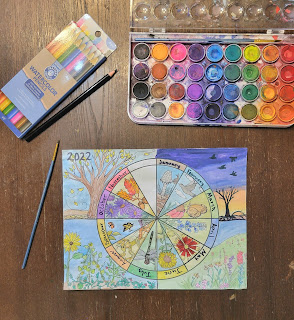I am always looking for new ways to incorporate nature and art into our days. Sometime last year I stumbled upon phenology wheels on Instagram and immediately fell in love with the idea.
What is a Phenology Wheel and Why Make One?
A phenology wheel is an artistic way to record nature observations and observations of seasonal and cyclical change. The basic idea is to record nature observations like weather, wildlife, and plant life on a wheel shaped chart on a monthly or daily basis throughout the year.
It can be a great way for you and your children to connect with nature and learn about the seasons. Recording our nature observations can help us slow down and notice things we may not otherwise, like changes in plants and trees, changes in the season, how the moon moves through its phases, animal life cycles, and what kinds of wildlife are present in your area during different parts of the year. It's also a fantastic way to add a little art to your homeschool days!
Getting Started
First choose whether you want to record your observations daily or monthly. You can make a wheel split into 12 sections, one for each month of the year to make monthly recordings on. You can also make monthly wheels split into 30 or 31 sections, one for each day of that month that you record daily observations on. Make your choice depending on how much time you personally want to dedicate to this project.
You will also want to decide what types of things you want to record on your wheel. Your wheel can be as simple as just a sketch or watercolor painting of something you observed for each month. If your planning a wheel for daily observations, you can make it a little more detailed, with spaces to record the daily weather and moon phase.
You can make your own wheel by tracing round lids or bowls or by using a protractor, but if you don't want to attempt your own, I have a free printable 12 month wheel available here, or the Paper, Wool, and Yarn blog has several printable wheels for daily observations here.
Once you have decided what type of wheel you want to make and have it drawn or printed, it's time to start recording your observations!
A Peak at Our Phenology Wheels
In 2020, I did a series of wheels, one for each month, with space for recording daily observations. I recorded the weather, high and low temperatures, and moon phase on my wheel. Around the outside I sketched plant and animal life we encountered during that month.
This year my girls and I are each working on year long wheels for monthly recordings.
If you enjoyed this post, check out:
And be sure to grab a free printable phenology wheel here!
Follow me on:







Comments
Post a Comment